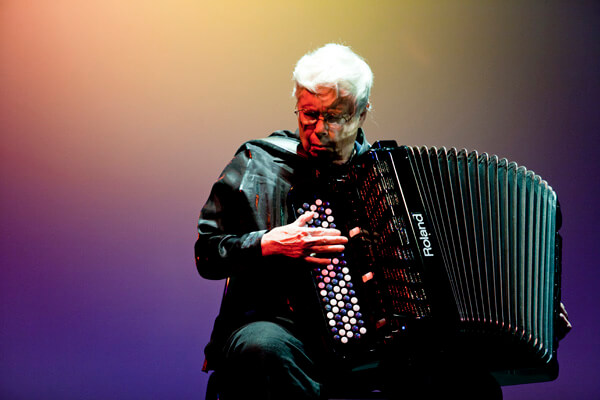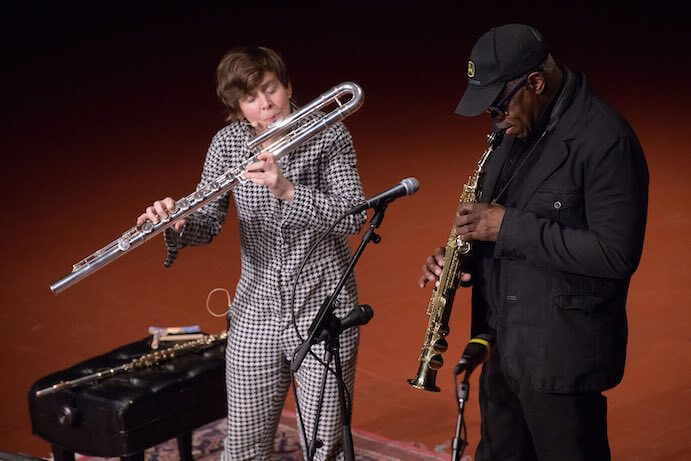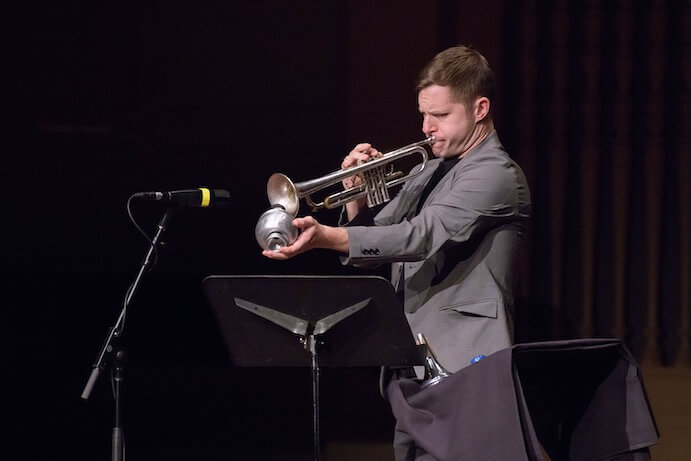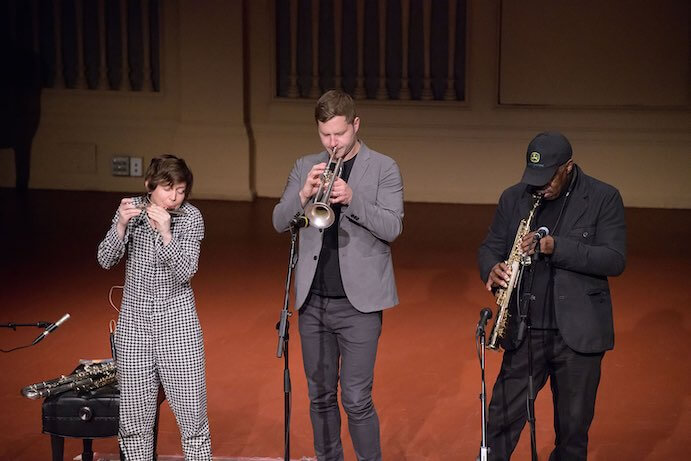On Saturday, March 23, in collaboration with the Carnegie Museum of Art’s 57th triennial Carnegie International, “A Night of Deep Listening” was presented by the Andy Warhol Museum’s prestigious Sound Series. The program brought together the remarkable talents of flutist Claire Chase, trumpeter/composer Peter Evans, and the legendary multi-instrumentalist/composer Joe McPhee to celebrate the late Pauline Oliveros and her defining philosophical performance practice, Deep Listening.
The concert was an extension of a multi-faceted installation by artist Josiah McElheny with curators John Corbett and Jim Dempsey entitled Dusty Groove II: Space is a Diamond, which was on display as part of the International in the Carnegie Museum’s Ailsa Mellon Bruce Galleries. Described in the International’s pocket guide as three friends who “look at art as intensely as they listen to music,” Dusty Groove II is the third such collaboration between McElheny, Corbett, and Dempsey. Through a display of assorted archival objects, photographs, drawings, and fanciful musical instruments, the trio endeavored to build a crossroads at which the staunch individualism of the “far-out virtuosos” to which their piece paid homage might meet, bringing them together to “affiliate the singular” and mingle their separate paths into something new and transcendent.

Composer Pauline Oliveros. Photo credit: Vinciane Verguethen
At the center of this eclectic assortment of objects were two large sculptures by McElheny, each an expression of the musical works and philosophies of 20th-century giants Harry Partch and Pauline Oliveros. The title, “Space is a Diamond,” was taken from the work of the same name by Polish-American composer Lucia Dlugoszewski who, like Oliveros and Partch, was known for her deeply philosophical approach to composition and for the invention and construction of special musical instruments, many of which were on display. At its most abstract, the installation represented the performance of a kind of sculptural chamber music that combined the influence and identities of these maverick personalities and synthesized a new possibility in imagined sound with Oliveros’ Deep Listening at its core.
Curator-collaborator John Corbett joined Chase, Evans, and McPhee as Saturday night’s emcee, and described his work in satisfying depth (and with pragmatic brevity) emphasizing the great fortune of having McPhee himself in attendance. Various pieces of paraphernalia from McPhee’s career were included in Dusty Groove II, and inspired the creation of a natural trumpet sculpted by McElheny from blue glass and called Cosmic Love after one of McPhee’s compositions.
McPhee opened the performance with a quote from Oliveros, saying, “We listen in order to hear, we hear in order to interpret the world around us, and babies are the best deep listeners.” Following a heartfelt anecdote about how meeting Oliveros in 1981 strongly contributed to the profound evolution of his craft, McPhee went on to read a wonderful poem he called The Ship with Marigold Sails in honor of his late friend and colleague.

Claire Chase and Joe McPhee–© Carnegie Museum of Art, Pittsburgh. Photo: Bryan Conley
Claire Chase followed with an extraordinary performance of Edgard Varèse’s Density 21.5 and a newly commissioned work by Phyllis Chen entitled Roots of Interior. Written for flute accompanied by amplified, pre-recorded sounds of Chase’s own heartbeat, this incredible piece took the DNA of Varèse’s work and spawned something wholly new that seemed quite literally to emanate from within Chase’s body. The energy and enthusiasm with which Chase performed swirled like a tightly controlled tornado that erupted volcanically with mind-bending extended techniques, then ebbed into periods of glacial serenity during which the sounds of her heart filled the sepulchral hall. Standing alone on a tattered oriental rug, the envelope of gloomy incandescent light that surrounded her seemed to float like a bubble in the rising darkness of the space, taking on the characteristics of a sensory deprivation tank. In a final coda, Chase was assisted by Corbett who held a stethoscope-like microphone to her chest, capturing her live heartbeat, which pounded fiercely in time with the final expressive currents of Chen’s remarkable piece.
McPhee next joined Chase in a performance of Pauline Oliveros’ Thirteen Changes, an exciting series of miniatures that run the gamut of expressive noise-making from guttural vocalizations to toy instruments. This was followed by Oliveros’ Sounds from Childhood: Sonic Meditation, a piece that implored all in attendance to produce their “favorite childhood noises” and listen carefully for others who make similar sounds around them.
To close the first half of the concert, Peter Evans emerged with trumpet in hand, and in a remarkable display of artistry, performed Dlugozewski’s Space Is a Diamond for solo trumpet. The work received its first performance in the context of a 1972 recording by Nonesuch Records, and according to the program, Evans’ performance was the first in over 40 years, perhaps since its debut.

Peter Evans–© Carnegie Museum of Art, Pittsburgh. Photo: Bryan Conley
Following a brief intermission McPhee performed his solo Wind Cycles, a last-minute addition to the program, which he previously performed in a Southern California music festival the year he met Oliveros. The remainder of the program was entirely improvised in an iterative series of pairings between the three performers, culminating with an epic trio punctuated by a final, touching poem read by McPhee and dedicated to Oliveros. To witness the expertise with which Chase, Evans, and McPhee interacted, carefully listening to the spontaneous, emergent patterns and incidental textures in order to navigate the gravity of their combined efforts like swirling cosmic bodies was a fitting summary of Oliveros’ mission to “reinvent music through radical empathy and sonic awareness,” that is to say, Deep Listening. This was experimental music at its finest, and music making in its most primordial and purest form. Indeed, as a sonic apparition of Dusty Groove II’s concept, “A Night of Deep Listening” built a sound sculpture bonded together by the mystery of inspiration, as fleeting and spontaneous as a flame but perhaps the most permanent point in a new artistic constellation.





















